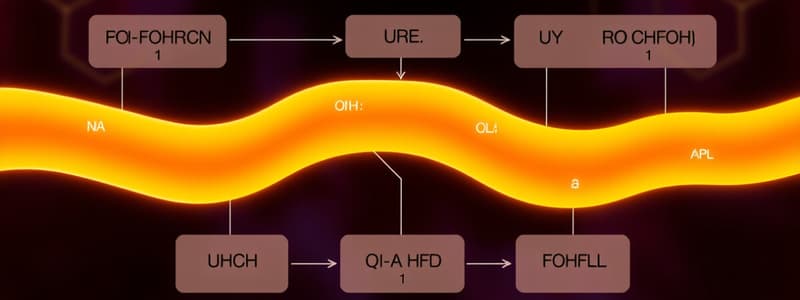Podcast
Questions and Answers
What role does N-acetyl glutamate play in the urea cycle?
What role does N-acetyl glutamate play in the urea cycle?
- It is a byproduct of the urea cycle.
- It inhibits the activity of carbamoyl phosphate synthetase I.
- It acts as an allosteric effector for carbamoyl phosphate synthetase I. (correct)
- It provides a direct substrate for the urea cycle.
What does arginine become upon cleavage during the argininosuccinate process?
What does arginine become upon cleavage during the argininosuccinate process?
- Carbamoyl phosphate
- Oxaloacetate
- Urea
- Fumarate (correct)
How is malate produced from fumarate in the urea cycle?
How is malate produced from fumarate in the urea cycle?
- Through condensation with acetyl CoA.
- By a direct enzymatic reaction with urea.
- By oxidative phosphorylation.
- Through hydration of fumarate. (correct)
Which of the following amino acids significantly increases the activity of Acetylglutamate Synthetase?
Which of the following amino acids significantly increases the activity of Acetylglutamate Synthetase?
What metabolic pathway does oxaloacetate enter after being oxidized from malate?
What metabolic pathway does oxaloacetate enter after being oxidized from malate?
What dietary intervention is critical for children with partial deficiencies to prevent mental retardation?
What dietary intervention is critical for children with partial deficiencies to prevent mental retardation?
Which of the following substances is administered to help reduce serum ammonia levels?
Which of the following substances is administered to help reduce serum ammonia levels?
What is one of the primary sources of ammonia in the blood?
What is one of the primary sources of ammonia in the blood?
What enzyme is associated with the conversion of glutamate to ammonia in the liver?
What enzyme is associated with the conversion of glutamate to ammonia in the liver?
In metabolic conditions leading to elevated ammonia, how is some of the serum ammonia utilized?
In metabolic conditions leading to elevated ammonia, how is some of the serum ammonia utilized?
Why is it critical to keep the blood ammonia level low?
Why is it critical to keep the blood ammonia level low?
Which compound is NOT mentioned as a source of ammonia?
Which compound is NOT mentioned as a source of ammonia?
What must be done when protein intake is restricted in children with ammonia metabolism issues?
What must be done when protein intake is restricted in children with ammonia metabolism issues?
What drives the formation of carbamoyl phosphate in the urea cycle?
What drives the formation of carbamoyl phosphate in the urea cycle?
Which enzyme is responsible for the initial step of carbamoyl phosphate formation?
Which enzyme is responsible for the initial step of carbamoyl phosphate formation?
Which metabolite is transported into the cytosol during the urea cycle?
Which metabolite is transported into the cytosol during the urea cycle?
Which amino acid is regenerated with each turn of the urea cycle?
Which amino acid is regenerated with each turn of the urea cycle?
What is formed as a product of the argininosuccinate synthesis reaction?
What is formed as a product of the argininosuccinate synthesis reaction?
What is the function of N-acetylglutamate in the urea cycle?
What is the function of N-acetylglutamate in the urea cycle?
Which reaction in the urea cycle requires the hydrolysis of a third molecule of ATP?
Which reaction in the urea cycle requires the hydrolysis of a third molecule of ATP?
What is the general role of glutamate dehydrogenase in urea cycle reactions?
What is the general role of glutamate dehydrogenase in urea cycle reactions?
What is one consequence of high concentrations of ammonia in the body?
What is one consequence of high concentrations of ammonia in the body?
Which condition is associated with acquired hyperammonemia?
Which condition is associated with acquired hyperammonemia?
Which metabolic reaction is shifted due to high ammonia levels?
Which metabolic reaction is shifted due to high ammonia levels?
What is the role of renal glutaminase in ammonia transport?
What is the role of renal glutaminase in ammonia transport?
What is the effect of liver cirrhosis on ammonia levels in the body?
What is the effect of liver cirrhosis on ammonia levels in the body?
How is ammonia primarily excreted from the body?
How is ammonia primarily excreted from the body?
Why is the brain particularly vulnerable to hyperammonemia?
Why is the brain particularly vulnerable to hyperammonemia?
What happens to ammonia present at low levels in the blood?
What happens to ammonia present at low levels in the blood?
What effect does ammonia have on a-ketoglutarate levels?
What effect does ammonia have on a-ketoglutarate levels?
Which amino acids are primarily released by muscle during nitrogen transport?
Which amino acids are primarily released by muscle during nitrogen transport?
Which of the following is NOT a cause of acquired hyperammonemia?
Which of the following is NOT a cause of acquired hyperammonemia?
What is the main pathway for ammonia disposal in the body?
What is the main pathway for ammonia disposal in the body?
Which intermediate is depleted due to the shift towards glutamate formation in the presence of ammonia?
Which intermediate is depleted due to the shift towards glutamate formation in the presence of ammonia?
Where does bacterial action contribute to ammonia production?
Where does bacterial action contribute to ammonia production?
What happens to urea after it is formed in the liver?
What happens to urea after it is formed in the liver?
What is the significance of ammonia in maintaining acid-base balance?
What is the significance of ammonia in maintaining acid-base balance?
Flashcards are hidden until you start studying
Study Notes
Urea Cycle Overview
- Urea cycle reactions are critical for ammonia detoxification and occur across mitochondria and cytosol.
- Phosphate (Pi) promotes the forward reaction in the cycle.
Enzyme Functions and Reactions
-
Carbamoyl Phosphate Formation
- Initiated by carbamoyl phosphate synthetase I, requiring N-acetylglutamate.
- Two ATP molecules are utilized to drive the reaction.
-
Argininosuccinate Synthesis
- Involves the cleavage of a third ATP molecule, producing AMP and pyrophosphate (PPi).
- Uses aspartate generated from a transamination reaction between oxaloacetate and glutamate.
-
Argininosuccinate Cleavage
- Produces arginine (urea precursor) and fumarate.
- Fumarate can convert to malate, linking to other metabolic pathways.
Role of Ornithine and Citrulline
- Ornithine is regenerated in each cycle turn and serves as an intermediary.
- Citrulline must be transported to the cytosol from mitochondria.
Allosteric Regulation
- N-acetyl glutamate acts as a crucial allosteric activator for carbamoyl phosphate synthetase I.
- Higher levels of N-acetylglutamate are stimulated by amino acids, especially arginine.
Treatment for Urea Cycle Disorders
- Low-protein diets supplemented with arginine or citrulline are crucial for managing ammonia levels.
- Sodium benzoate and sodium phenylacetate help reduce serum ammonia by facilitating excretion.
Ammonia Metabolism
- Blood ammonia must be maintained at low levels due to its neurotoxic potential.
Ammonia Sources
-
From Amino Acids
- Synthesized by the liver through aminotransferase and glutamate dehydrogenase reactions.
-
From Glutamine
- Renal glutaminase converts glutamine into ammonia, primarily excreted as NH4+.
-
From Intestinal Bacterial Action
- Bacteria in the intestine produce ammonia, which can be reabsorbed and transported via the portal system.
Toxicity Mechanisms
-
High ammonia levels may lead to coma or death.
-
Chronic acquired hyperammonemia often results from liver diseases, including viral hepatitis and cirrhosis.
-
An increase in glutamate formation from high ammonia depletes alpha-ketoglutarate, disrupting TCA cycle processes, crucial for ATP production in brain cells.
Studying That Suits You
Use AI to generate personalized quizzes and flashcards to suit your learning preferences.




